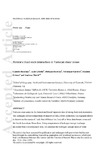Meteoric fluid‐rock interaction in Variscan shear zones
| dc.contributor.author | Dusséaux, C | |
| dc.contributor.author | Gébelin, A | |
| dc.contributor.author | Boulvais, P | |
| dc.contributor.author | Gardien, V | |
| dc.contributor.author | Grimes, Stephen | |
| dc.contributor.author | Mulch, A | |
| dc.date.accessioned | 2019-06-24T11:29:26Z | |
| dc.date.available | 2019-06-24T11:29:26Z | |
| dc.date.issued | 2019-04-09 | |
| dc.identifier.issn | 0954-4879 | |
| dc.identifier.issn | 1365-3121 | |
| dc.identifier.other | ter.12392 | |
| dc.identifier.uri | http://hdl.handle.net/10026.1/14383 | |
| dc.description.abstract |
<jats:title>Abstract</jats:title><jats:p>Variscan shear zones in the Armorican Massif represent sites of strong fluid‐rock interaction. The hydrogen isotope composition of muscovite (δ<jats:styled-content style="fixed-case">D<jats:sub>M</jats:sub></jats:styled-content><jats:sub>s</jats:sub>) from syntectonic leucogranite allows to determine the source of fluids that infiltrated the footwall of three detachment zones and the South Armorican Shear Zone. Using temperatures of hydrogen isotope exchange estimated from microstructural data, we calculate the hydrogen isotope ratios of water (δD<jats:sub>water</jats:sub>) present within the shear zones during high‐temperature deformation. A ~40‰ difference in δD<jats:sub>water</jats:sub> values from deep to shallow crustal level reveals a mixing relationship between deep crustal fluids with higher δD values that range from −34 to −33‰, and meteoric fluids with δD values as low as −74‰ in the upper part of detachment footwalls.</jats:p> | |
| dc.format.extent | 366-372 | |
| dc.language | en | |
| dc.language.iso | en | |
| dc.publisher | Wiley | |
| dc.title | Meteoric fluid‐rock interaction in Variscan shear zones | |
| dc.type | journal-article | |
| dc.type | Journal Article | |
| plymouth.author-url | https://www.webofscience.com/api/gateway?GWVersion=2&SrcApp=PARTNER_APP&SrcAuth=LinksAMR&KeyUT=WOS:000475470900006&DestLinkType=FullRecord&DestApp=ALL_WOS&UsrCustomerID=11bb513d99f797142bcfeffcc58ea008 | |
| plymouth.issue | 4 | |
| plymouth.volume | 31 | |
| plymouth.publication-status | Published | |
| plymouth.journal | Terra Nova | |
| dc.identifier.doi | 10.1111/ter.12392 | |
| plymouth.organisational-group | /Plymouth | |
| plymouth.organisational-group | /Plymouth/Faculty of Science and Engineering | |
| plymouth.organisational-group | /Plymouth/Faculty of Science and Engineering/School of Geography, Earth and Environmental Sciences | |
| plymouth.organisational-group | /Plymouth/REF 2021 Researchers by UoA | |
| plymouth.organisational-group | /Plymouth/REF 2021 Researchers by UoA/UoA07 Earth Systems and Environmental Sciences | |
| plymouth.organisational-group | /Plymouth/Users by role | |
| plymouth.organisational-group | /Plymouth/Users by role/Academics | |
| dcterms.dateAccepted | 2019-03-27 | |
| dc.rights.embargodate | 2020-4-8 | |
| dc.identifier.eissn | 1365-3121 | |
| dc.rights.embargoperiod | Not known | |
| rioxxterms.versionofrecord | 10.1111/ter.12392 | |
| rioxxterms.licenseref.uri | http://www.rioxx.net/licenses/all-rights-reserved | |
| rioxxterms.licenseref.startdate | 2019-04-09 | |
| rioxxterms.type | Journal Article/Review |


